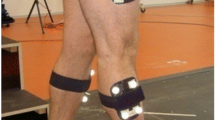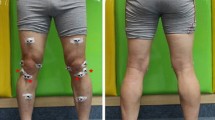Abstract
The purpose of this investigation was to use relative phase dynamics to evaluate gait in individuals with a reconstructed anterior cruciate ligament (ACL) during walking and running. Relative phase dynamics can describe the coordination strategies between the interacting segments at the lower extremity. Ten subjects who had undergone ACL reconstruction using the central third of their patellar tendon and ten healthy controls walked and ran on a treadmill at a self-selected pace. Relative phase dynamics were calculated for the foot–shank and shank–thigh coordinative relationships. Statistical differences between the groups were noted for the foot–shank relationship (p<0.05) during both walking and running and for the shank–thigh relationship (p<0.05) during walking. Our results indicate that current ACL reconstructive techniques may result in altered relative phase dynamics. These changes in relative phase dynamics could be related to a loss of sensory information about joint position and velocity that is typically provided by the intact ACL. Additionally, relative phase adaptations could be a learned response from the early stages of postsurgical rehabilitation. Relative phase dynamics provide quantitative information about the dynamic status of the ACL-reconstructed knee that cannot be gained from the conventional time-series evaluation of gait analysis data. Relative phase dynamics measures should supplement the conventional gait analysis measures that are used today for the clinical evaluation of the functional dynamic stability of the reconstructed knee. The examination of relative phase dynamics could be clinically important for the quantification of new ACL surgical interventions and of patient performance at various stages of rehabilitation. Further research should incorporate relative phase dynamics to understand the influence of ACL reconstruction on coordination and functional patient outcomes.



Similar content being viewed by others
References
Baker D, Wilson G, Carlyon B (1994) Generality versus specificity: a comparison of dynamics and isometric measures of strength and speed-strength. Eur J Appl Physiol 68:350–355
Barela JA, Whitall J, Black P, Clark JE (2000) An examination of constraints affecting the intralimb coordination of hemiparetic gait. Hum Mov Sci 19:251–273
Bonfim TR, Jansen Paccola CA, Barela JA (2003) Proprioceptive and behavior impairments in individuals with anterior cruciate ligament reconstructed knees. Arch Phys Med Rehabil 84(8):1217–1223
Bulgheroni P, Bulgheroni MV, Andrini L, Guffanti P, Giughello A (1997) Gait patterns after anterior cruciate ligament reconstruction. Knee Surg Sports Traumatol Arthrosc 5:14–21
Burgess-Limerick R, Abernethy B, Neal RJ (1993) Relative phase quantifies interjoint coordination. J Biomech 26(1):91–94
Bush-Joseph CA, Hurwitz DE, Patel RR, Bahrani Y, Garretson R, Bach BR et al (2001) Dynamic function after anterior cruciate reconstruction with autologous patellar tendon. Am J Sports Med 29(1):36–41
Cappozzo A, Catani F, Leardini A, Benedetti MG, Croce CD (1996) Position and orientation in space of bones during movement: experimental artefacts. Clin Biomech 11:90–100
Daniel DM, Malcom LL, Losse G et al (1985) Instrumented measurement of anterior laxity of the knee. J Bone Joint Surg Am 67:720–726
Davids K, Glazier P, Araujo D, Bartlett R (2003) Movement systems as dynamical systems. The functional role of variability and its implications for sports medicine. Sports Med 33(4):245–260
Devita P, Hortobagyi T, Barrier J, Torry M, Glover KL, Speroni DL, Money J, Mahar MT (1997) Gait adaptations before and after anterior cruciate ligament reconstruction surgery. Med Sci Sports Exerc 29(7):853–859
Devita P, Hortobagyi T, Barrier J (1998) Gait biomechanics are not normal after anterior cruciate ligament reconstruction and accelerated rehabilitation. Med Sci Sports Exerc 30(10):1481–1488
Ferber R, Osternig LR, Woollacott MH, Wasielewski NJ, Lee JH (2002) Gait mechanics in chronic ACL deficiency and subsequent repair. Clin Biomech 17:274–285
Friden T, Roberts D, Ageberg E, Walden M, Zatterstrom R (2001) Review of knee proprioception and the relationship to extremity function after anterior cruciate ligament rupture. J Ortho Sports Phys Ther 31:567–576
Georgoulis AD, Papadonikolakis A, Papageorgiou CD, Mitsou A, Stergiou N (2003) Three-dimensional tibiofemoral kinematics of the anterior cruciate ligament-deficient and reconstructed knee during walking. Am J Sports Med 31(1):75–79
Gottlieb GL, Agarwal GC, Jaeger RJ (1983) Response of sudden torques about the ankle in man. V. Effects of peripherial ischemia. J Neurophys 50:297–312
Hamill J, van Emmerik RE, Heiderscheit BC, Li L (1999) A dynamical systems approach to lower extremity running injuries. Clin Biomech 14(5):297–308
Hara K, Kubo T, Suginoshita T et al (2000) Reconstruction of the anterior cruciate ligament using a double bundle. Arthroscopy 16:860–864
Heiderscheit BC, Hamill J, van Emmerik RE (1999) Q-angle influences on the variability of lower extremity coordination during running. Med Sci Sports Exerc 31(9):1313–1319
Heier K, Mack D, Mosely J, Paine R, Bocell J (1997) An analysis of anterior cruciate ligament reconstruction in middle aged patients. Am J Sports Med 25:527–532
Jackson KM (1979) Fitting of mathematical functions to biomechanical data. IEEE Trans Biomed Eng 26:515–521
Johansson H, Sjolander P, Sojka P (1991) A sensory role for cruciate ligaments. Clin Orthop Rel Res 268:161–178
Jomha NM, Pinczewski LA, Clingeleffer A et al (1999) Arthroscopic reconstruction of the anterior cruciate ligament with patellar-tendon autograph and interference screw fixation. The results of seven years. J Bone Joint Surg 81B:775–779
Kurz MJ, Stergiou N (2004) Applications of dynamical systems theory for movement analysis. In: Stergiou N (ed) Innovative analyses of human movement. Human Kinetics, Champaign
Kwakkel G, Wagenaar RC (2002) Effect of duration of upper- and lower-extremity rehabilitation sessions and walking speed on recovery of interlimb coordination in hemiplegic gait. Phys Ther 82(5):432–448
McCloskey DI (1978) Kinesthetic sensibility. Phys Rev 58:763–820
Muneta T, Sekiya I, Yagishita K, Ogiuchi T, Yamamoto H, Shinomiya K (1999) Two-bundle reconstruction of the anterior cruciate ligament using semitendinosus tendon with endobuttons: operative technique and preliminary results. Arthroscopy 15(6):618–624
Noyes F, Barber-Westin S (1997) A comparison of results in chronic anterior cruciate ligament rupture of arthroscopically assisted autogenous patellar tendon reconstruction. Am J Sports Med 25:460–471
Reinschmidt C, van den Bogert AJ, Nigg BM, Lundberg A, Murphy N (1997) Effect of skin movement on the analysis of skeletal knee joint motion during running. J Biomech 30:729–732
Reinschmidt C, van Den Bogert AJ, Murphy N, Lundberg A, Nigg BM (1997) Tibiocalcaneal motion during running, measured with external and bone markers. Clin Biomech 12:8–16
Rudroff T (2003) Functional capability is enhanced with semitendinosus than patellar tendon ACL repair. Med Sci Sports Exerc 35(9):1486–1492
Sakane M, Fox RJ, Woo SL et al (1997) In situ forces in the anterior cruciate ligament and its bundles in response to anterior tibial loads. J Orthop Res 15:285–293
Scholz JP (1990) Dynamic pattern theory—some implications for therapeutics. Phys Ther 70(12):827–842
Snyder-Mackler L, Binder-Macleod S, Williams P (1993) Fatigability of human quadriceps femoris muscle following anterior cruciate ligament reconstruction. Med Sci Sports Exerc 25:783–789
Sparto PJ, Parniapour M, Reinsel TE, Simon S (1997) The effect of fatigue on multijoint kinematics, coordination, and postural stability during a repetitive lifting test. JOSPT 25(1):3–12
Timoney JM, Inman WS, Quesada PM, Sharkey PF, Barrack RL, Skinner HB et al (1993) Return to normal gait patterns after anterior ligament reconstruction. Am J Sports Med 21(6):887–889
Van den Berg C, Beek PJ, Wagenaar RC, van Wieringen PC (2000) Coordination disorders in patients with Parkinson’s disease: a study of paced rhythmic forearm movements. Exp Brain Res 134(2):174–186
Van Uden CJT, Bloo JKC, Kooloos JGM, van Kampen A, de Witte J, Wagenaar RC (2003) Coordination and stability of one-legged hopping patterns in patients with anterior cruciate ligament reconstruction: preliminary results. Clin Biomech 18:84–87
Winstein CJ, Garfinkel A (1989) Qualitative dynamics of disordered human locomotion: A preliminary investigation. J Motor Behav 21(4):373–391
Yasuda K, Sasaki T (1987) Exercise after anterior cruciate ligament reconstruction: the force exerted on the tibia by the separate isometric contraction of the quadriceps or the hamstrings. Clin Orthop Rel Res 7:275–283
Zhang LQ, Minorik JM, Lin F, Koh JL, Makhsous M, Bai Z (2001) ACL strain during simulated free-speed walking. In: Proceedings of the 25th annual meeting of American Society of Biomechanics. San Diego
Acknowledgements
This research project was partially funded by the University of Nebraska at Omaha Rhoden Biological Research Fellowship granted to M.J.K. Experiments performed in this investigation complied with the ethical treatment standards and current laws of the United States of America.
Author information
Authors and Affiliations
Corresponding author
Rights and permissions
About this article
Cite this article
Kurz, M.J., Stergiou, N., Buzzi, U.H. et al. The effect of anterior cruciate ligament recontruction on lower extremity relative phase dynamics during walking and running. Knee Surg Sports Traumatol Arthrosc 13, 107–115 (2005). https://doi.org/10.1007/s00167-004-0554-0
Received:
Accepted:
Published:
Issue Date:
DOI: https://doi.org/10.1007/s00167-004-0554-0




